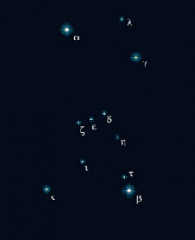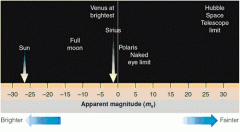![]()
![]()
![]()
Use LEFT and RIGHT arrow keys to navigate between flashcards;
Use UP and DOWN arrow keys to flip the card;
H to show hint;
A reads text to speech;
10 Cards in this Set
- Front
- Back
|
Where are the remaining 48 ancient constellations that we still recognize today located?
|
at mid and northern celestial latitudes
|
|
|
What is the most likely Greek letter name of the second brightest star in the constellation Lyra?
|

beta Lyrae
|
|

In the constellation Orion, we receive more light from the star Rigel (β) than we do from the star Betelgeuse (α). Why does this figure have the alpha and beta designations as shown?
|
This is one exception to the way in which brightness has been assigned in this system.
|
|
|
The apparent visual magnitudes of four stars are listed below. Of these four stars, which one appears dimmest in the sky?
+2.8 - 0.5 -1.2 It cannot be determined from the given information. +0.7 |
+2.8
|
|
|
Which pair of apparent visual magnitudes listed below indicates that we receive about 16 times as much visible light from star W than we do from star X? mv star W = 16, and mv star X = 1 mv star W = 2, and mv star X = 5 mv star W = 5, and mv star X = 2 mv star W = 1, and mv star X = 6 mv star W = 1, and mv star X = 16 |
mv star W = 2, and mv star X = 5
|
|
|
The apparent visual magnitude of star A is 2 and the apparent visual magnitude of star B is 1. Based on this information which statement below must be true?
Light output and distance cannot be determined from a star's apparent visual magnitude alone. Star B emits more light than star A. Star A is closer than star B. Star B is closer than star A. Star A emits more light than star B. |
Light output and distance cannot be determined from a star's apparent visual magnitude alone.
|
|

Notice in this figure that the magnitude scale is "awkward" in that the smaller, or more negative, magnitude number corresponds to a brighter star. Why does this scale have this "awkward" direction?
|
The system was originally set up as a set of classes with first class as the brightest.
|
|
|
When you observe a star on the celestial equator for a period of a few hours, you notice it moves from ______-to-_______ relative to the horizon
|
east, west |
|
|
At what location on Earth is an observer that has the South Celestial Pole directly overhead?
|
at Earth's South Pole (90 degrees South latitude)
|
|
|
At what location on Earth is an observer that has the Celestial Equator pass through the point directly overhead?
|
at Earth's equator (0° latitude)
|

